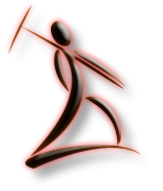
Professional Chimney Sweep Tamworth, Sutton Coldfield, Lichfield, Nuneaton, Birmingham, Solihull & Surrounding Telephone 07407 453630
MASTER SWEEPS
CHIMNEY SWEEP SPECIALIST
07407 453630



Master Sweeps. 4 The Bodnetts, Plantation Lane, Hopwas, Tamworth, Staffs B78 3AU Tel: 07407 453630
There are two types or methods of chimney sweeping currently in use. The first method is known as the Traditional method and the second is called the Power Sweeping method.
Traditional Sweeping
Most people are familiar with the ‘traditional’ method of chimney sweeping and it is the method as depicted in the Mary Poppins film.
The traditional chimney sweeping method uses a round brush which can be made from Polypropylene or metal wire bristles (the size or diameter of the brush used being dependant upon the diameter of the flue to be swept) which is attached to a rod (usually 3 feet long or one meter in new money. The brush is then pushed up inside the chimney flue and then pulled down and then pushed up into the flue again several times. This brushing motion causes the bristles on the brush to rubs against the sides of the chimney flue. The end result is that any soot inside the flue is dislodged and falls down under gravity to the fire appliance below, where it will be vacuumed away.
In order for the brush to travel and clean the full length of the flue the chimney sweep will attach additional rods to the previous rod. A typical flue length in a standard residential property is between 8 to 10 meters, or 26 to 30 feet in old money. The more times a chimney sweep pushes up and then retracts the brush inside the chimney flue the more soot is dislodged and hence the cleaner the flue.
This method of chimney sweeping is ideal for older properties where the condition of the chimney flue lining, i.e., rendering, is weak, perhaps due to age, and is easily removed. The fact is we want the rendering to remain on the chimney flue wall for as long as possible because the purpose of the rendering is to provide a seal or shield to the inside of the chimney flue so that smoke and gases (carbon monoxide) cannot escape through the chimney flue and into the property. That is why the rendering was put there in the first place by the bricklayers who built the property. So we don’t actually want to remove any of the rendering if at all possible. So a gentle approach is required and desired. The traditional sweeping method is ideal for sweeping older flues.
Beware the lazy chimney sweep who only pushes and retracts his (or her) brush up into the flue only once!
Traditional sweeping is a gentler sweeping method where consideration to the preservation of the liner rendering must be given. However, a chimney brush when pushed up and through a brick chimney flue exerts a fair amount of outward pressure against the bricks of the flue. See the video above ‘Kinder to brick flues’. Too much pressure on an old and fragile brick chimney flue can cause the bricks that make up the flue to dislodge and fall out. Not good! Power sweeping can be a better sweeping method option to use in these circumstance since power sweeping does not exert any appreciable outward force (as can be seen in the ‘Kinder to Brick Flues’ video above).
Beware the lazy chimney sweep who uses a brush that has a diameter too large or too small for the flue.
A brush that has too large a diameter may exert too much force on the inside of the flue causing damage to the structure of the flue. A brush that is too small for the flue being swept will result in an ineffective sweep since the brush will not make contact with the chimney flue walls. A single power sweep brush head contains nylons strands that can sweep flues from anywhere between 4 inches and 2 feet! One brush fits all sizes. So it’s almost impossible with the power sweeping method to use the wrong brush size.
Power Sweeping
Until recently chimney sweeps really only had one method to sweep chimneys and that was the ‘Traditional’ method, as described above. As technology has advanced the chimney sweep’s arsenal of equipment options have increased. Advances in plastics have made the chimney sweep’s rods lighter and more flexible, yet stronger than previous materials used, e.g. cane (Malacca) or Polypropylene. Rods are even made from aluminium, offering strength and rigidity while remaining lightweight. A well equipped sweep will now have, in addition to a set of traditional brushes and rods, a power sweeping kit and a number of different types and sizes of electric drills, both cabled and cordless.
The most obvious difference between traditional sweeping and power sweeping is the brush used. With power sweeping the brush or ‘head’ looks a bit like a large spider. The sweeping head comprising thick nylon strands as opposed to thin bristles, which is usually what traditional brushes are made from.
The second major and obvious difference is that with power sweeping the ‘head’ rotates at speed. With the traditional method the head is pushed up and pulled down manually.
There is simply no argument or doubt in terms of which method of sweeping is better at and more effective in removing soot and creosote. Power sweeping is the clear winner. However, because power sweeping is a robust whipping action method of flue cleaning care must be taken when using this cleaning system. If the head rotates at too high a rate the rendering in an older flue can be damaged, i.e., the rendering can be removed.
An experienced chimney sweep will identify the type of flue, e.g., rendered, clay, stainless steel flexi or concrete sectional, as soon as they arrive and before they commence the sweeping process. At this pre-
Brushes containing metal bristles should not be used under any circumstances on steel liners. Metal bristles would scratch the liner and provide a ‘key’ for creosote to attach to to. The liner would then suffer the effects of corrosion as a result. Only soft nylon bristled brushes should be used on metal liners.
Clay liners and to some extent brick flues can have excessive deposits of creosote removed with a ‘chain flay’. Power sweeping comes into it’s own here when heavy creosote deposits need to be removed. Traditional sweeping would struggle to remove anything like the amount of creosote power sweeping with a chain flay can remove. Again, if the flue is of the rendered kind a chain flay should not be allowed anywhere near the flue! The result of doing so would be a flue devoid of all rendering!
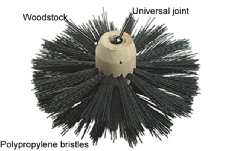
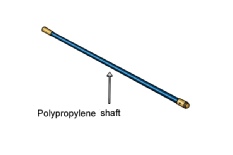
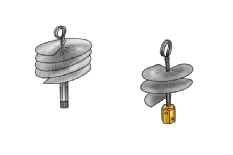
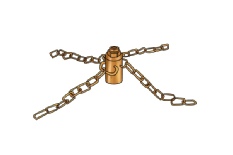
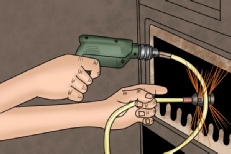
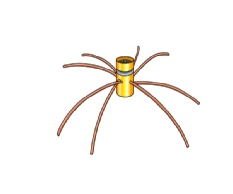
The traditional method
Power Sweeping method
Kinder To Brick Flues
Power Sweeping A Liner
Wife Too Close To Camera
Traditional Brush
Traditional Rods
Wire Brushes
Power Sweep Head
Chain Flay
Nylon Flexi Rods
 EMF Form Builder
EMF Form BuilderTo arrange a chimney sweep call me on Tel: 07407 453630
Or leave a message requesting a call back and I will return your call within the hour
Alternatively, you can send me a message by filling in the form opposite and I will respond quickly to your enquiry.
If you are looking for a quote just let me know the approximate location of the property and the type of fire appliance you use, e.g, open fireplace or stove.
I will then provide you with the cost of a sweep.
Chimney sweeper Clifton Campville, Alrewas, Fradley, Burntwood, Tamworth, Solihull, Knowle, Dorridge, Olton, Chimney sweeper Birmingham, Edgbaston, Erdington, Harborne, Selly Oak, Perry Barr, Castle Bromwich, Coleshill, Hurley, Baxterley, Fillongley, Sutton Coldfield, Haunton, stove fitter, stove installer
Traditional Sweeping Vs Power Sweeping
& Gets Soot On Face


